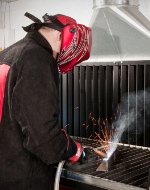
Preparing for 2011 Fabrication and Finishing Rules
Manufacturers that use welding in their operations should get ready to meet this year's notification deadlines for Clean Air Act emission regulation.
- By Deanna Postlethwaite, Kathy Gargasz
- Apr 07, 2011
Manufacturers that engage in metal fabrication and finishing must be prepared to comply with fast-approaching deadlines for the U.S. Environmental Protection Agency's National Emissions Standard for Hazardous Air Pollutants (NESHAPs). As soon as July, companies will need to notify the agency that their facilities fall under the standard for Metal Fabrication Hazardous Air Pollutants (MFHAP).
Step 1. Is This a Rule to Worry About?
To determine applicability, the first step is to scan EPA's nine source categories and note whether any of them characterize your company's primary production operation.
The categories are:
Electrical and electronic equipment finishing operations
Fabricated metal products
Fabricated plate work (boiler shops)
Fabricated structural metal manufacturing
Heating equipment, except electric
Industrial machinery and equipment finishing operations
Iron and steel forging
Primary metal products manufacturing
Valves and pipe fittings
These nine categories have five primary processes in common ─ dry abrasive blasting, dry grinding and dry polishing with machines, machining, spray painting, and welding ─ that are likely to emit MFHAPs. The agency defines a primary production operation as one in which the manufacturing, fabrication, or forging operations at a single facility comprise at least half of the total production in one of the categories and processes. If your company measures production in terms of volume, linear or square foot, or other terms, those terms will be used to calculate whether a facility meets the 50-percent threshold. EPA considers any compound or elemental form of cadmium, chromium, lead, manganese, or nickel (with the exception of lead in elemental form) to be a MFHAP.
In many cases, large manufacturers are major sources of hazardous air pollutants (HAPs) and regulated by Maximum Achievable Control Technology rules. MFHAP regulations are a subset of these and will affect small- to medium-sized businesses determined to be area sources. An area source is an operation that has the potential to emit less than 10 tons annually of a single HAP or less than 25 tons annually of a combination of multiple HAPs.
In welding, facilities that use 2,000 lbs. or less annually of any particular welding rod or wire will have to comply with management and recordkeeping requirements. Those that use more rod or wire annually will have to perform emissions monitoring in addition to the other requirements.
The critical dates for this year's deadlines are July 25 and Nov. 22. By the first date, existing sources of MFHAPs must notify EPA of their applicability status. In November, existing sources must submit a notification of compliance, including proper operation and maintenance of equipment, a welding management plan, and visual determination of emissions at the primary stack or exit from the building with evidence of the testing results.
Step 2. Training for Testing Requirements
Existing sources must use EPA Method 9 and 22 to test for emissions. The first test method requires training and certification, so it is not too early to get started on this process. Compliance guidelines also require, depending on the facility and its processes, that testing be performed repeatedly.
Step 3. Documenting Compliance
If the rule applies, facility owners and operators are required to produce supporting documentation demonstrating that
- employees are operating and maintaining equipment to the manufacturer’s specifications;
- the company has implemented one or more welding practices ─ adopting alternative processes, selecting different filler metals or shielding gases, optimizing procedures and/or adding fume control systems ─ to minimize MFHAP emissions.
Because Lincoln Electric is working to ensure manufacturers are aware of the EPA MFHAP – NESHAPS rule, the firm cannot directly assist a fabricator with its compliance efforts. However, the company can assist fabricators in gathering the right materials, identifying potential solutions in a welding management plan, and periodically conducting informal audits of welding fume solutions in place to suggest paths for improvement.
This summary of governmental regulations is provided for informational purposes only. Customers should consult with legal counsel to determine which regulations apply to their operations and what must be done to comply with those regulations.
About the Authors
Deanna Postlethwaite is marketing manager for the Lincoln Electric Automation Division.
Kathy Gargasz is environmental coordinator at Lincoln Electric. For information, send e-mail to weldfumecontrol@lincolnelectric.com.